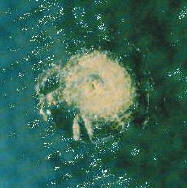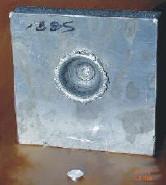






| Website Stats |
Visits from over |
|
Free downloads |
You can now read the material from this website on most electronic devices: -On your computer
Two NEW books from the author of BibleHelp
|
UFO -4: High Speed Collisions (Part 4 of 8)
Back

The space shuttle window after
being hit by a flake of paint
Chapter: 11.10
(Section 11: Understanding God and His Universe)
Copyright © Michael Bronson 1997, 1999, and 2000
BibleHelp.org
Summary
Hitting a object as small as a paint flake can cause a great deal of damage for our spaceships. Hitting a grain of sand at 90% of the speed of light will cause an impact equal to hitting a 400,000 ton weight.
Click Here for a book version of this material
In the previous chapter I showed how it was impossible to propel a spaceship to speeds near the speed of light. We saw that to propel NASA’s space shuttle to a speed 50% of the speed of light would consume the same amount of energy that the whole U.S. consumes in 108 years. (To slow the ship down would take another 108 years worth of energy.) I also showed that our most powerful fuel (nuclear power) would still be over 98 times too heavy (power-to-mass ratio) to get the ship to the desired speed.
Some people, however, will still insist that technology can overcome all obstacles. They believe that traveling near the speed of light is an obtainable goal. Most of these people don’t realize that even if these speeds could be obtained, ultra high-speed space travel is still unrealistic. There is another limiting factor that most people have not considered. In ultra high-speed travel, speed itself becomes our biggest enemy.
Ultra high-speeds cause three major problems. First, higher speeds increase the damage brought on by a collision. Second, higher speeds reduce the pilot’s ability to detect objects in his path. Third, higher speeds reduce the pilot’s ability to avoid objects once they have been detected.
Running into large objects is bad at any speed, but running into something as small as a grain of sand can be destructive for high-speed travelers. In 1983, a small paint flake struck the space shuttle Challenger with such force that it gouged a small crater in the front window4.1 (see the picture above). The damage was so great the window had to be replaced after the flight (costing $50,000). Many windows, in fact, have been replaced over the years because of this problem. It is the speed of the impact that makes these small objects so destructive. If the shuttle had been hit by an object 1/35th the weight (mass) of an aspirin, it would have struck with the impact of a .30 caliber bullet.
Most people are surprised that a paint flake can cause so much damage. Imagine what the damage would be like if the shuttle was traveling 20 times faster (the speed necessary to reach the nearest star in 7,900 years). You would think that if the speed was 20 times greater, the impact would be 20 times greater. It isn’t; it is actually 400 times greater. You can see the reason for this if you look at the formula for kinetic energy.
Kinetic energy = (½) (mass) (velocity) (velocity)
Since velocity is listed twice in this formula, any increase in velocity makes a big difference in the amount of kinetic energy generated. If the shuttle had been traveling 100 or 1000 times faster, the impact would be 10,000 and 1,000,000 times greater (respectively). If a paint flake can do this much damage, imagine what a rock or boulder could do to a spaceship.
The pictures below provide another example of the damage caused by high-speed impacts. In this situation, an object about the size of a nickel (1.5 grams, 1.6 cm diameter), was shot toward an inch thick aluminum plate at 1.5 miles a second (4,900 mph). If this projectile had been moving at the same speed as the paint flake, the impact would have been 11 times greater.


The tables below will provide you a visual idea of the damage brought on by high-speed impacts. The first table shows the damage caused by high-speed impacts of various objects 4.2. The next two tables show the amount of energy created by various impacts.
Depth of penetration from a 6.2 miles/sec impact4.3
Diameter (inches) |
0.039 |
0.083 |
0.173 |
0.378 |
0.83 |
1.77 |
Mass (ounces) |
0.00035 |
0.0035 |
0.035 |
0.35 |
3.5 |
35 |
Penetration depth (inches) |
0.201 |
0.429 |
0.925 |
1.992 |
4.291 |
9.244 |
Force of impact caused by an object the size of a pea
Weight: 10 grams
Diameter: .96 cm
Speed of the impact (miles per hour) |
Example of impact force |
Force equivalence (This would be the same as being hit by a weight falling at 100 mph) |
22,300 |
7/10th of a hand grenade |
a .5 ton weight |
100 thousand |
15 hand grenades |
a 11 ton weight |
500 thousand |
363 hand grenades |
a 275 ton weight |
1 million |
1,454 hand grenades |
a 1,100 ton weight |
2 million |
1 ton of TNT |
a 4,400 ton weight |
50% speed of light |
2.2 atomic bombs4.4 |
a 124 million ton weight |
90% speed of light |
7 atomic bombs4.4 |
a 401 million ton weight |
Force of impact caused by a grain of sand
Weight: .01 gram
Diameter: .1 cm
Speed of the impact (miles per hour) |
Example of impact force |
Force equivalence (This would be the same as being hit by a weight falling at 100 mph) |
22,300 |
1 bullet (.30-cal) |
a 1.1 pound weight |
100 thousand |
22 bullets (.30-cal) |
a 22 pound weight |
500 thousand |
.4 hand grenade |
a 550 pound weight |
1 million |
1.5 hand grenades |
a 1.1 ton weight |
2 million |
5.8 hand grenades |
a 4.4 ton weight |
50% speed of light |
27 tons of TNT |
a 124,000 ton weight |
90% speed of light |
87.5 tons of TNT |
a 401,000 ton weight |
(Source: Artificial Space Debris, p69 and Dept of Aerospace Engineering Science, University of Colorado.)
As you can see from the tables above, ultra high-speed impacts can be devastating to a spaceship. The impact by a pebble flying at 90% of the speed of light will produce energy equal to seven atomic bombs. There is no way of building a spaceship that can withstand this type of impact. Since, there will never be a way of being able to detect these small objects at great distances, ultra high-speed travel is not a realistic possibility.
Footnotes: The footnote section for the UFO chapters has 10 pages of calculations. I have, therefore, put all of the footnotes and calculations on another web page to keep these web pages cleaner looking. Click on the link below to go to the footnotes:
Other Chapters in this Section
Home
Tell a Friend about this page

